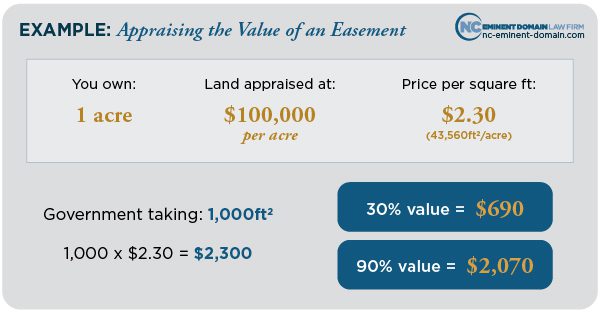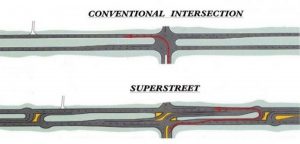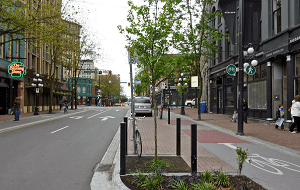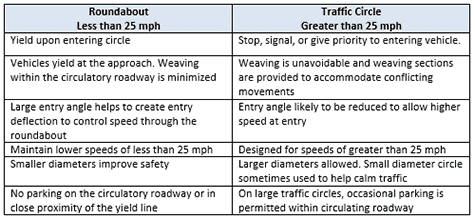We get it, your home is your investment. And the type of road that runs in front of or alongside your property can have a significant impact on its value. Not many homeowners want to live beside a roaring roadway!
“Superstreets” are the latest threat to homeowners who just want peace and quiet. As land condemnation attorneys in NC, we often represent property owners who live along roads that are being widened or changed, and these changes often affect their homes or businesses. This article breaks down the nuances of superstreets and how an attorney can help you if your property is affected by the construction of one.
What is a superstreet?
Superstreets are a type of intersection between a major road and a minor road that provide an alternative route to drivers on the minor road who wish to proceed straight across the major road or turn left onto it. Below, we’ll explain what a superstreet is in more detail, and why NCDOT is building so many in NC.
A closer look: Definition of a superstreet
When two roads cross each other, you get an interchange. In a “typical” red light/green light intersection, you can turn right, left, or go straight from any direction.
The superstreet concept is an alternative to this type of intersection.
In a superstreet intersection scenario, roads joining the superstreet can only turn right onto it. To turn left and travel in the other direction, drivers must first turn right and then make a U-turn. Superstreets are also called restricted crossing U-turns (RCUT), J-turns, and reduced conflict intersections (RCI).
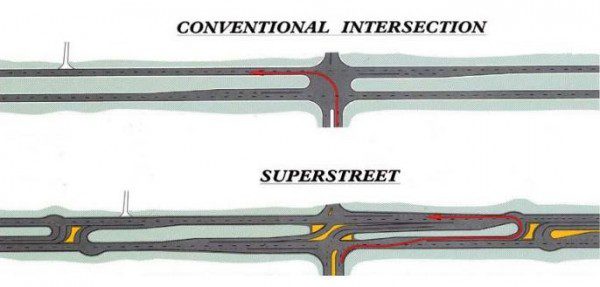
Are superstreets safe?
While the superstreet design looks complicated, planners often prefer it because it simplifies the number of choices for drivers – minimizing the conflict points at an intersection.
A typical intersection may have as many as 32 potential conflict points, while a superstreet only has 14.
Since intersections have long been a trouble spot for motorists and are often the scene of some of the most devastating accidents, NCDOT engineers hope that by reducing the number of conflict points, they might reduce the number of accidents.
It seems they are right.
How much safer are superstreets? Here’s an example.
In 1997, the NCDOT converted the NC 87 bypass to North Carolina’s first superstreet. In the three years prior to opening it, the bypass was the scene of 24 crashes, resulting in 21 injury cases.
For the three-year span after the bypass was converted, there was a remarkable drop to only two crashes and zero injury cases, according to the NCDOT.
Analyzing data over a seven-year period, the NCDOT estimated that superstreets reduce collisions by 46%.
Superstreets are also considered safer for pedestrians because traffic patterns are easier to predict since drivers have fewer options (conflict points).
Why does the NCDOT think a superstreet is a super street?
In addition to the improved safety (reduced likelihood of crashes and threats to crossing pedestrians), superstreets are appealing to NCDOT for three other reasons:
- More efficient – Since superstreets have fewer conflict points, there are fewer stoplights, and the stoplights that are in place do not have to accommodate as many options. This reduces travel time and allows the road to accommodate more traffic.
- Economically beneficial– Since superstreets allow for equal access to both sides of the road, development can more easily occur on either side. Also, when used as a substitute for an interchange, superstreets are typically less expensive, since they require less acreage (see picture below).
- Environmentally friendly– In addition to affecting less land than a conventional interchange, vehicles spend less time idling at stoplights with superstreets, leading to fewer emissions and pollutants released into the environment.
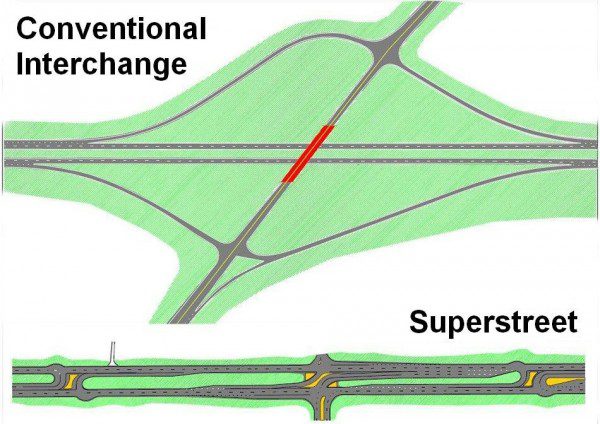
A non-compensable inconvenience: Another reason the NCDOT prefers superstreets
Imagine you run a business that loses all of the traffic from one direction because a median was installed and turning across it is forbidden. Sounds like much more than an inconvenience, right? Unfortunately, in North Carolina, eliminating the ability to turn left or installing a median that may prevent traffic from entering or flowing in some ways is typically NOT considered a taking.
Your business would likely be harmed but because the law generally does not recognize these modifications as a taking, you would likely not be compensated.
What do I do if my road is being turned into a superstreet?
While superstreets may have benefits, they can cause problems for homeowners who are in the way of the project. Building a new superstreet (or converting an existing street into one) can require right-of-way acquisition, which means the government may take the land needed for the project from private owners using a process called eminent domain.
If your property is in danger of being taken, we strongly recommend that you get a free case evaluation with an experienced eminent domain attorney as soon as possible. In our experience, the government may undervalue your property and offer you less than what you may deserve. And, without guidance, it’s easy to miss important deadlines or accidentally take steps that can’t be reversed.
How can the NC Eminent Domain Law Firm help me?
If your property is affected by a superstreet project, our firm can help you navigate the eminent domain process and fight for the compensation you deserve by:
- Advising you of your rights as a property owner
- Helping you understand the rationale and process for the taking
- Interpreting complex eminent domain laws
- Identifying the possible elements to include in compensation calculations
- Fronting the costs of surveyors, engineers, or appraisers for property evaluation, if needed
At the NC Eminent Domain Law Firm, we have four eminent domain attorneys who have worked for the NCDOT, and they may be able to use that inside experience and knowledge to your benefit. Our attorneys have more than 80 years of combined experience trying many different kinds of cases throughout North Carolina.
We’re happy to review your case to see if you’re being treated fairly. If we take your case, we do not charge you an hourly fee. Instead, we collect a contingency fee at the end of the case, which is a percentage of the total amount that we may secure for you above the amount the NCDOT offered you. If we do not recover additional compensation over what the government offered you, there is no attorney’s fee.
Call us today at 1-877-393-4990 or contact us online for a free case evaluation.
